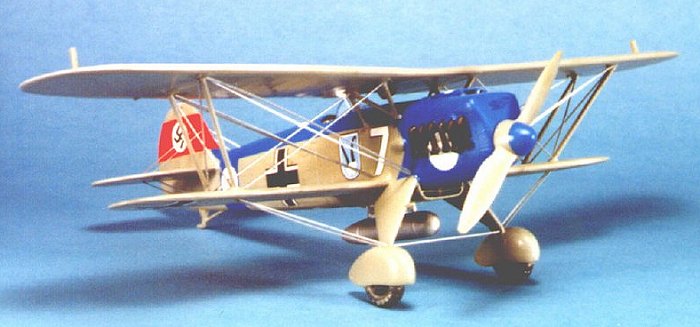
|
KIT # |
407 |
|
PRICE: |
$29.95 |
|
DECALS: |
See Review |
|
REVIEW : |
|
|
NOTES: |

|
HISTORY |
There is a saying in aviation design that,
"if it looks right, it is right." While this is generally true, it was
unfortunately not the case as regards the Heinkel He-51, which was a completely
orthodox biplane of undistinguished performance, though this was due to the
failure of the German aircraft industry of the period to develop suitable
high-performance engines as was happening in Great Britain at Rolls-Royce. Had
the He-51 been powered by a Kestrel, like its contemporary the Hawker Fury,
things might have been different, even if it was nowhere near as maneuverable as
that famous classic.
The airplane first appeared as the He-51a. The Technischen
Amt of the Luftfahrtkommisariat became interested when it was
revealed it had a higher performance than the Arado Ar-65E which was planned as
the first fighter equipment of the still-secret Luftwaffe, with the same BMW 6.0
ZU engine; this fighter promised performance that would equal the international
standard. Introduced into service as the He-51A-0, the fighter equipped
the DVL Reklame-Staffel Mitteldeutschland, the "Central Germany
Publicity Squadron," which would later become known as II/JG.132 "Richtofen"
when the Luftwaffe was revealed to the rest of Europe in 1935. Early
accidents were laid to deficiencies in training rather than anything intrinsic
to the design. The He-51B differed from its predecessor in having twin-wire
bracing of the landing gear, and the ability to carry a 50-liter drop tank
beneath the fuselage. As production proliferated in 1936-37, so did the Jagdgeschwader
mounted on the elegant-looking fighter, with their colorful unit markings. The beginning of the end for the He-51 came in January 1936.
The Luftwaffefuhrungsstab considered that the Arado Ar-68 offered little
over the Heinkel in terms of performance and questioned putting it into
production. Ernst Udet, Inspector of Fighter and Dive Bomber Pilots, decided to
resolve the question. Mounted in the Ar-68E, with a very experienced pilot in an
He-51, Udet out-climbed, out-dove and out-maneuvered the Heinkel fighter with
ease. In retrospect, the failure of the He-51 when it entered combat
was ultimately a good thing for the Luftwaffe, since it forced the service to
bring the Messerschmitt Bf-109 into operational use far earlier than would
otherwise have been the case, subjecting that great design to the pressure of
wartime development from the beginning of its career, and assuring it of the
ascendancy it would hold when war finally broke out in Europe three years later.
As well, the early introduction of the Bf-109 into combat forced the pilots of
the Luftwaffe to abandon the useless formations and tactics of the biplane era,
and create tactics and formations appropriate to a high-speed fighter; this
would mean they could out fly their enemies for at least the first two years of
the Second World War, since their opponents still used the outmoded tactics.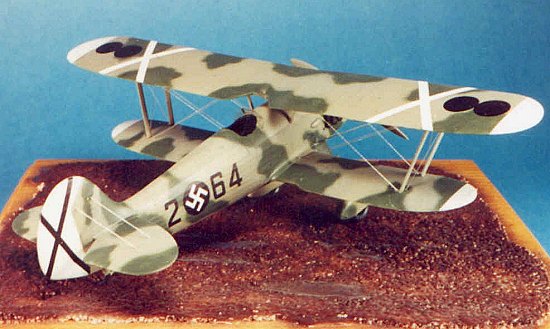 What was
important about the He-51 from a design standpoint was its elegance of line,
being the first design to come from the aestheic of designer Walter Gunter;
complemented by the mathematic genius of his twin brother Siegfried, these two
would provide the indelible hallmark "look" of Heinkel aircraft of the
Thirties.
What was
important about the He-51 from a design standpoint was its elegance of line,
being the first design to come from the aestheic of designer Walter Gunter;
complemented by the mathematic genius of his twin brother Siegfried, these two
would provide the indelible hallmark "look" of Heinkel aircraft of the
Thirties. Later that
year, in response to requests from General Francisco Franco, Hitler decided to
provide support to the Nationalists in what was developing into the Spanish
Civil War. Six He-51s were sent to Spain with six German pilots to instruct
Spanish pilots. Unfortunately, the airplane was a "handful" for the
Spanish, who immediately wrote off two of them. The Germans entered combat
unofficially and met with such success that it was decided a
"volunteer" fighter squadron would be seconded to the Spanish, to
allow Luftwaffe pilots to gain invaluable combat experience. At about the
same time, Polikarpov I-15s flown by Soviet "volunteers" appeared on
the side of the Republicans. When the two fighters met, it was no contest as to
which was the better: the "Chato" could fly rings around the Heinkel,
as well as outgun it, and the He-51s were reduced to targets, unfit to take part
in aerial combat. The He-51 became a ground attack fighter for the remainder of
its service in Spain, and was replaced in Luftwaffe service as rapidly as
possible.
Later that
year, in response to requests from General Francisco Franco, Hitler decided to
provide support to the Nationalists in what was developing into the Spanish
Civil War. Six He-51s were sent to Spain with six German pilots to instruct
Spanish pilots. Unfortunately, the airplane was a "handful" for the
Spanish, who immediately wrote off two of them. The Germans entered combat
unofficially and met with such success that it was decided a
"volunteer" fighter squadron would be seconded to the Spanish, to
allow Luftwaffe pilots to gain invaluable combat experience. At about the
same time, Polikarpov I-15s flown by Soviet "volunteers" appeared on
the side of the Republicans. When the two fighters met, it was no contest as to
which was the better: the "Chato" could fly rings around the Heinkel,
as well as outgun it, and the He-51s were reduced to targets, unfit to take part
in aerial combat. The He-51 became a ground attack fighter for the remainder of
its service in Spain, and was replaced in Luftwaffe service as rapidly as
possible.
|
THE KIT |
The Classic Airframes He-51 appeared in 1996, and was the first 1/48 rendering of this airplane other than a Wings vacuform of the early 1980s. The Wings kit had excellent surface detail and made up into an accurate model, but the fact it was a vacuform consigned it to be built only by connoisseurs.
 The kit
comes from that period in Classic Airframes that saw each release vary wildly in
terms of production quality from that before or after. The I-153 that
immediately preceded this model was excellent. The He-51 has a heaviness in its
molding that requires a bit of effort by a modeler with some fine sandpaper and
polish to obtain a nice finish. Decals were by Propagteam, and provided markings
for an early He-51 in Luftwaffe service, and the He-51 flown by Ltn. Hajo Harrer
of the Condor Legion during the Spanish Civil War.
The kit
comes from that period in Classic Airframes that saw each release vary wildly in
terms of production quality from that before or after. The I-153 that
immediately preceded this model was excellent. The He-51 has a heaviness in its
molding that requires a bit of effort by a modeler with some fine sandpaper and
polish to obtain a nice finish. Decals were by Propagteam, and provided markings
for an early He-51 in Luftwaffe service, and the He-51 flown by Ltn. Hajo Harrer
of the Condor Legion during the Spanish Civil War.
Fortunately, by the time I built these models, far better decals for the He-51 were available on two sheets, 48-456 and 48-458, from Aeromaster, released along with the first volume of Eric Mombeek's new series on Luftwaffe colors. I opted for an He-51B-2 of JG135 from 48-456; for the combat airplane, I used 48-458 to create Hajo Harrer's He-51 of J/88, the fighter unit of the Condor Legion.
|
CONSTRUCTION |
The model is as straightforward in construction as any limited-run kit. The modeler needs to cut the parts from the thick sprues with a razor saw and clean them up, then test fit parts before gluing them for final assembly.
The cockpit is multi-media, with resin floor and sidewall, injection-molded seat, and photoetch brass for the instrument panel and details like seat belts, etc. All of this was painted with Tamiya RLM Gray, and assembled per the kit instructions.
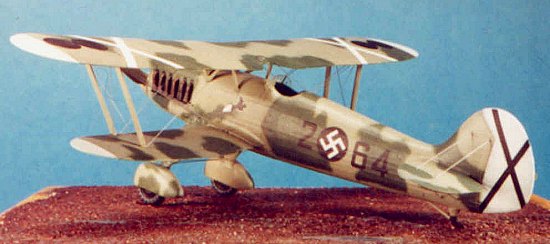 With the
fuselage assembled, I attached the lower wings after I had drilled out locating
holes and inserted some Evergreen rod to strengthen the joint. I did the same
with the horizontal stabilizers, which also have only a butt-joint. I trimmed
and fit the landing gear legs and then attached them.
With the
fuselage assembled, I attached the lower wings after I had drilled out locating
holes and inserted some Evergreen rod to strengthen the joint. I did the same
with the horizontal stabilizers, which also have only a butt-joint. I trimmed
and fit the landing gear legs and then attached them.
There was a lot of cutting and fitting to get the interplane and cabane struts to fit properly (this is a continuing problem with Classic Airframes kits, but soon the model was ready for painting. With the Luftwaffe version, I made the mistake of believing that the molded position indicators for the struts were correct; this is not the case, since the positions shown on the lower surface of the upper wing are too far outboard all the way around. This resulted in struts that are splayed-out too far, with a wing that is too low. When I did the Spanish Civil War airplane, I looked at the three-view drawing in "Warplanes of the Third Reich," and used the head-on profile to get the struts at the correct angle. The difference between the two isn't that much, but it is significant. Had I not already completed and rigged the first model, I would have re-done it. If you do this model, be sure to have three-view drawings and follow them.
|
PAINT & DECALS |
According to the Tom Tullis profiles in "Birth of the Luftwaffe," Volume 1 of the series, the He-51 was painted overall RLM63 Grau. This is a greenish-grey, lighter in hue than RLM02 Grau. As I studied the profile, I realized that Gunze-Sanyo "RLM Gray" - which is much lighter than its Tamiya equivalent or anyone else's RLM02 - is very close to RLM63 Grau, and in fact could have been produced from a mistaken analysis of RLM63, inasmuch as RLM02 was always considered the "proper" exterior color in the early Luftwaffe - it turns out RLM02 was not the first color used. I first painted the geschwader color - in this case blue - over the upper fuselage, then masked it off and painted the rest of the model overall with the Gunze-Sanyo color. When that was dry, I shot the model with Future and was ready for decals.
For the Spanish Civil War airplane, I first painted the white rudder and wingtips, then masked them off and painted the model with Gunze-Sanyo RLM02, following that with Gunze Sanyo Medium Green for the field-applied camouflage, which was applied according to the painting guide that came with the decal sheet.
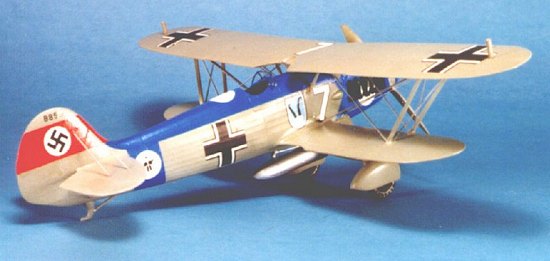 I did my He-51 as an He-51B-1 of JG135, the former fighter
squadron of the Austrian Air Force prior to the Anschluss. The Aeromaster
decals went down easily under a light coat of MicroSol. When they had fully set,
I washed the model to get rid of solvent residue, then gave it another coat of
Future. Since this was a period when the staffels prided themselves on
maintaining a pristine appearance to their aircraft, I did not weather the
model.
I did my He-51 as an He-51B-1 of JG135, the former fighter
squadron of the Austrian Air Force prior to the Anschluss. The Aeromaster
decals went down easily under a light coat of MicroSol. When they had fully set,
I washed the model to get rid of solvent residue, then gave it another coat of
Future. Since this was a period when the staffels prided themselves on
maintaining a pristine appearance to their aircraft, I did not weather the
model.
The decals for the Spanish Civil War version went on equally well.
Final Assembly and Detailing:
Before assembling the upper wing on the Spanish Civil War version, I weathered this model with mud on the wheels and spats, a spray of mud on the tail from the tail skid, with blast residue and exhaust staining.
I glued the upper wing back on and set the windscreen in position. As an experiment, I rigged the Luftwaffe model using Evergreen .010" x .020" strip, which results in a good approximation of the "raf wires". I did the other model with my high-E guitar wire, which is a circular-section wire. Looking at the two, I think the guitar wire still looks better because it is thin, and I will likely re-rig the first model (I might even then decide to get radical and fix the strut problem).
|
CONCLUSIONS |
The Heinkel He-51 may not have been a world-beater in terms of performance, but in an era of good looking biplane fighters, it stood out for its elegance of design. As the first fighter of the restored Luftwaffe to see widespread service, and the first German fighter to see combat since the First World War, it is an important airplane and worthy of inclusion in any Luftwaffe collection that aims to be representative of the major types used by the service.
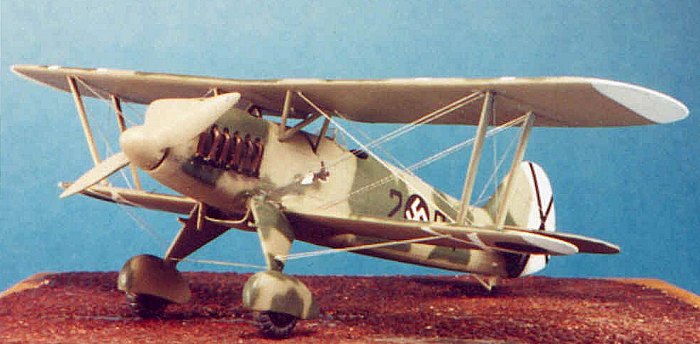
Copyright ModelingMadness.com. All rights reserved. No reproduction in part or in whole without express permission.
If you would like your product reviewed fairly and fairly quickly, please contact the editor or see other details in the Note to Contributors.